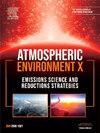对印度德里上空城市气溶胶化学老化的见解
IF 3.4
Q2 ENVIRONMENTAL SCIENCES
引用次数: 0
摘要
大气颗粒物在经过长途运输并与其他来源的颗粒物混合后会发生老化。这可能导致污染物的积累,并形成具有不同化学和物理特性的复杂气溶胶混合物。为了研究环境大气中的老化过程,2020 年 11 月至 2021 年 3 月期间,在新德里(北纬 28°38'10″,东经 77°10′17")的 CSIR 国家物理实验室,使用细颗粒采样器对锡基石英微纤维过滤器上的 PM2.5 气溶胶颗粒进行了 24 小时采样。根据对天气和气象参数的观测,选取了一些偶发事件,并对样本进行了大颗粒和单个颗粒分析。本研究的目的是调查气溶胶的老化特征,使我们能够了解气溶胶的混合情况(在体积和单个颗粒层面)以及偶发案例中新鲜和变形(与其他物种一起老化)石墨含量的变化。采用拉曼光谱技术测量气溶胶中石墨(G 带,约 1580 厘米-1)和无序石墨(D 带,约 1320 厘米-1)含量的强度。对单个颗粒的显微镜观察显示,存在单体大小不一的开链分形黑碳,有时与铜、铬、钙等金属聚集在一起,同时还存在富含 S 的有机气溶胶,而拉曼光谱(大量样品分析)则突出显示了石墨和无序(当石墨与其他化学物质相互作用时)石墨的强度。将重度灰霾和中度灰霾天的强度与非灰霾天的强度进行比较(为便于比较,2021 年 3 月 23 日的 PM2.5 浓度最低为 62 μg/m3 以下,被视为非灰霾天),发现灰霾天记录到的 G 波段强度高出 45 至 200 倍,D 波段强度高出 43 至 93 倍;而在中度灰霾天,G 波段强度高出 4 至 61 倍,D 波段强度高出 2 至 29 倍。这些研究结果表明,在雾霾天,对 BC 进行了化学处理。本文章由计算机程序翻译,如有差异,请以英文原文为准。

Insights into chemical aging of urban aerosols over Delhi, India
Atmospheric particles can undergo aging as they are transported over long distances and mix with particles from other sources. This can lead to the accumulation of pollutants and the formation of complex aerosol mixtures with diverse chemical and physical properties. To investigate the process of aging in ambient atmosphere, 24h sampling of PM2.5 aerosol particles on Quartz microfiber filter with a tin substrate was carried out from November 2020 to March 2021 at CSIR-National Physical Laboratory, New Delhi (28°38'10″ N and 77°10′17" E), using fine particle sampler. Based on the observations of weather and meteorological parameters, a few episodic cases have been selected, and samples were analyzed at bulk and individual particle level. The objective of the present study is to investigate the aging characteristics of aerosols, enabling us to understand the mixing of aerosols (at both bulk and individual particle levels) and the variation in fresh and deformed (aged with other species) graphitic content in the episodic cases. The Raman Spectroscopy technique employed measures the intensity of graphitic (G band; around 1580 cm−1) and disordered graphitic (D band; around 1320 cm−1) content of aerosols. Individual particle microscopic observations reveal the occurrence of open chain fractals of black carbon in variable monomer sizes, sometimes agglomerated with metals like Cu, Cr, Ca etc., along with the presence of S- rich and organic aerosols while the Raman Spectrum (bulk sample analysis) highlights graphitic and disordered (when graphite interacts with other chemical species) graphitic intensities. Comparing the intensities of heavy haze and moderate haze with non-haze days (for comparison purpose, March 23, 2021 with the lowest PM2.5 concentration ∼ 62 μg/m3, has been considered as a non-haze day), it was observed that the intensities recorded on haze days were 45 to 200 times higher for the G band and 43 to 93 times higher for the D band; while for moderate haze days, the intensities were 4 to 61 times higher for the G band and 2 to 29 times higher for the D band. These findings suggest chemical processing of BC during haze days.
求助全文
通过发布文献求助,成功后即可免费获取论文全文。
去求助
来源期刊

Atmospheric Environment: X
Environmental Science-Environmental Science (all)
CiteScore
8.00
自引率
0.00%
发文量
47
审稿时长
12 weeks
 求助内容:
求助内容: 应助结果提醒方式:
应助结果提醒方式:


